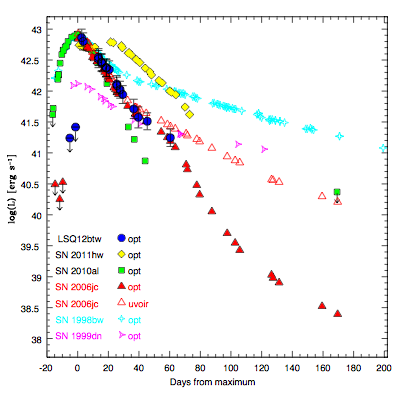Padova-Asiago Supernova Group
Highlights
Massive stars exploding in a He-rich circumstellar medium. VI. Observations of two distant Type Ibn supernova candidates discovered by La Silla-QUEST
Pastorello, A. et al. 2015, MNRAS 449, 1954 (link to pdf)
We present optical observations of the peculiar stripped-envelope supernovae (SNe) LSQ12btw and LSQ13ccw discovered by the La Silla-QUEST survey. LSQ12btw reaches an absolute peak magnitude of M(g) = -19.3 +- 0.2, and shows an asymmetric light curve. Stringent prediscovery limits constrain its rise time to maximum light to less than 4 days, with a slower post-peak luminosity decline, similar to that experienced by the prototypical SN~Ibn 2006jc. LSQ13ccw is somewhat different: while it also exhibits a very fast rise to maximum, it reaches a fainter absolute peak magnitude (M(g) = -18.4 +- 0.2), and experiences an extremely rapid post-peak decline similar to that observed in the peculiar SN~Ib 2002bj. A stringent prediscovery limit and an early marginal detection of LSQ13ccw allow us to determine the explosion time with an uncertainty of 1 day. The spectra of LSQ12btw show the typical narrow He~I emission lines characterising Type Ibn SNe, suggesting that the SN ejecta are interacting with He-rich circumstellar material. The He I lines in the spectra of LSQ13ccw exhibit weak narrow emissions superposed on broad components. An unresolved Halpha line is also detected, suggesting a tentative Type Ibn/IIn classification. As for other SNe~Ibn, we argue that LSQ12btw and LSQ13ccw likely result from the explosions of Wolf-Rayet stars that experienced instability phases prior to core collapse. We inspect the host galaxies of SNe Ibn, and we show that all of them but one are hosted in spiral galaxies, likely in environments spanning a wide metallicity range. 33
Pastorello, A. et al. 2015, MNRAS 449, 1954 (link to pdf)
We present optical observations of the peculiar stripped-envelope supernovae (SNe) LSQ12btw and LSQ13ccw discovered by the La Silla-QUEST survey. LSQ12btw reaches an absolute peak magnitude of M(g) = -19.3 +- 0.2, and shows an asymmetric light curve. Stringent prediscovery limits constrain its rise time to maximum light to less than 4 days, with a slower post-peak luminosity decline, similar to that experienced by the prototypical SN~Ibn 2006jc. LSQ13ccw is somewhat different: while it also exhibits a very fast rise to maximum, it reaches a fainter absolute peak magnitude (M(g) = -18.4 +- 0.2), and experiences an extremely rapid post-peak decline similar to that observed in the peculiar SN~Ib 2002bj. A stringent prediscovery limit and an early marginal detection of LSQ13ccw allow us to determine the explosion time with an uncertainty of 1 day. The spectra of LSQ12btw show the typical narrow He~I emission lines characterising Type Ibn SNe, suggesting that the SN ejecta are interacting with He-rich circumstellar material. The He I lines in the spectra of LSQ13ccw exhibit weak narrow emissions superposed on broad components. An unresolved Halpha line is also detected, suggesting a tentative Type Ibn/IIn classification. As for other SNe~Ibn, we argue that LSQ12btw and LSQ13ccw likely result from the explosions of Wolf-Rayet stars that experienced instability phases prior to core collapse. We inspect the host galaxies of SNe Ibn, and we show that all of them but one are hosted in spiral galaxies, likely in environments spanning a wide metallicity range. 33
